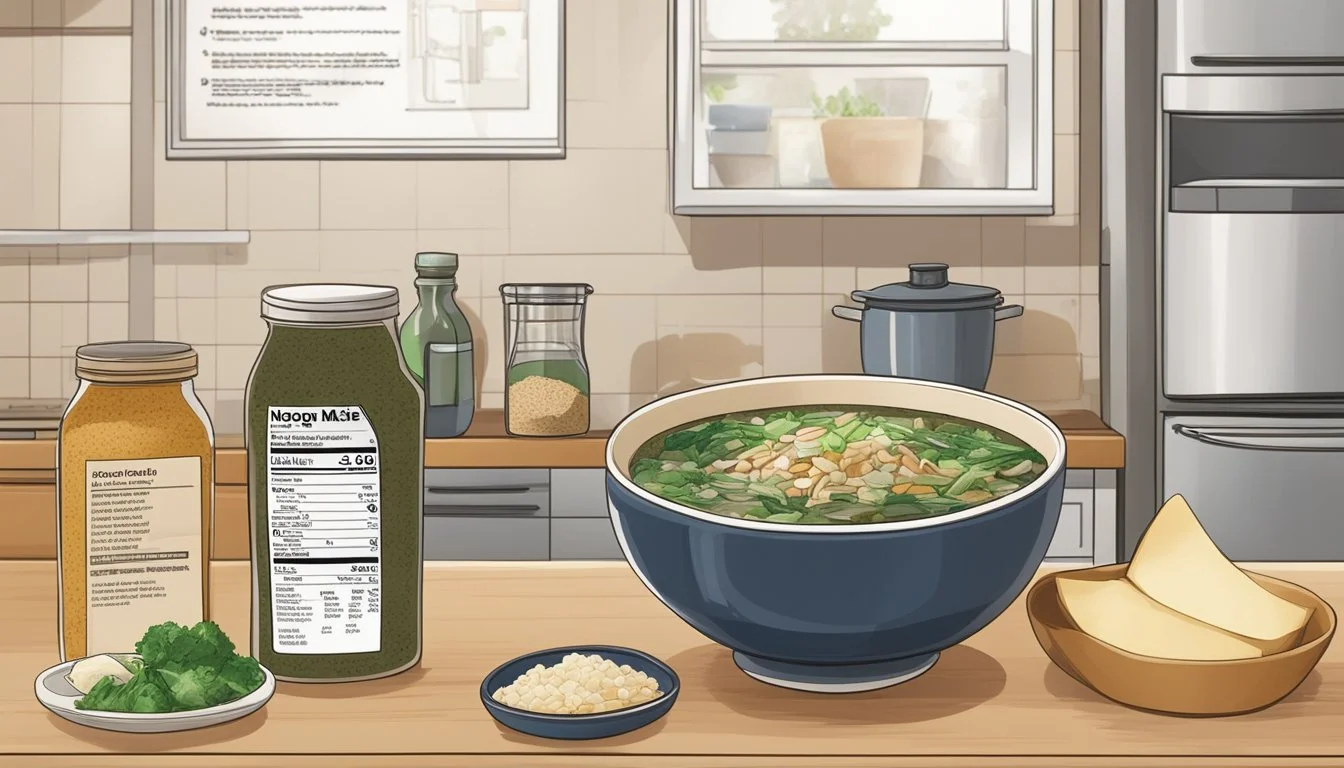Does Miso Soup Mix Go Bad?
Understanding Shelf Life and Storage Tips
Miso soup mix is a staple in Japanese cuisine, valued for its savory flavor and simplicity. An important consideration for anyone who keeps miso soup mix on hand is whether or not it goes bad. Unopened miso paste, a key ingredient in miso soup mix, does not go bad and can last indefinitely if stored properly in a cool, dry place.
When it comes to instant miso soup mixes, they typically have a shorter shelf life. These mixes usually expire after about two years. While the components of miso soup are generally stable, including dried tofu and seaweed, the flavor and quality can diminish over time.
Storing miso soup mix correctly is key to maintaining its flavor and safety. Keeping it in an airtight container in a refrigerator once opened will help extend its quality, but always check for any changes in taste or appearance.
Understanding Miso Soup Mix
Miso soup mix typically contains key ingredients like miso paste, dashi, and additional items such as tofu and seaweed. These ingredients contribute to its distinctive umami flavor and nutritional benefits. The fermentation process of the miso paste is crucial for developing its unique taste and extending its shelf life.
Ingredients and Varieties
Miso soup mix usually includes miso paste, a primary ingredient made from fermented soybeans, rice, and sometimes barley. The paste comes in various types, such as red, white, and yellow miso, each offering a unique flavor profile and intensity.
Red Miso: Strong, salty flavor, typically aged longer.
White Miso: Sweeter, milder, less time to ferment.
Yellow Miso: Balance of the two, versatile in use.
Common additions include tofu (cubed), seaweed (Wakame), and green onions. These ingredients complement the soup's umami character and add nutritional value, including protein and vitamins.
The Role of Fermentation
Fermentation is central to the creation of miso paste. This process involves the use of koji, a mold culture, combined with soybeans and grains like rice or barley. Over time, fermentation develops the paste's complex flavors and increases its storage life.
Fermentation not only enhances the umami taste but also supports digestive health by fostering beneficial bacteria. This process makes miso paste more nutrient-dense, aiding in the absorption of nutrients.
Proper storage and fermentation ensure the longevity and quality of miso paste in soup mixes. By avoiding exposure to air and keeping it refrigerated, the paste maintains its flavor and safety for extended periods.
Shelf Life and Expiration
Miso soup mix, whether unopened or opened, has particular storage requirements to maintain its quality and safety for consumption. Proper storage extends its shelf life significantly.
Unopened Miso Soup Mix
Unopened miso soup mix remains safe to eat as long as it is stored correctly. Typically, an unopened packet can last up to two years. The paste within the mix is preserved due to its high salt content and fermentation process, which prevent bacterial growth.
To store unopened miso soup mix, keep it in a cool, dry place away from direct sunlight. While the flavor might change slightly over time, the product remains safe. There is no specific expiration date, but checking for any noticeable changes in smell or color can help determine if it's best to discard.
Once Opened
Once opened, the shelf life of miso soup mix shortens considerably. An open packet should be stored in an airtight container to minimize exposure to air and moisture. When refrigerated, it can last 5-7 days.
It's crucial to follow manufacturer's recommendations on the packaging, as they provide the best guidance for optimal storage practices. Pay attention to any changes in taste or appearance, as these indicate the product is no longer at its best quality. Proper storage practices are essential to extend the mix's usability and maintain its flavor.
Signs of Spoilage
Miso soup mix can spoil, and recognizing the indicators is essential to ensure safe consumption. Key signs include visual and textural changes, along with alterations in odor and flavor.
Visual and Textural Changes
Spoiled miso soup mix may exhibit distinct visual changes. Mold growth is one of the most obvious indicators, manifesting as green, white, or black spots on the surface. If present, discard the mix immediately.
Texture also plays a role in identifying spoilage. Fresh miso should be smooth and consistent. Spoiled miso might become overly dry, clumpy, or slimy. Another sign is the change in color; if the miso darkens significantly, it may indicate microbial contamination or prolonged exposure to air and moisture.
Odor and Flavor Alteration
Miso's fermentation process naturally gives it a strong aroma. However, an off smell or sour, rancid odor indicates spoilage. This smell results from microbial contamination or breakdown of the fermented product.
Flavor changes also signal spoilage. Miso should taste umami and slightly sweet. If it has an unpleasant taste, is excessively salty, or has any sour notes, it’s best to discard it. Trust your senses; if the odor and taste seem off, do not consume the miso.
Proper Storage Practices
Proper storage of miso soup mix ensures that it maintains its flavor and nutritional value. Key practices differ for unopened and opened miso soup mix.
Storing Unopened Miso
Unopened miso soup mix can last indefinitely if stored correctly. It should be kept in a cool, dry place away from direct sunlight. The pantry is an ideal location.
Temperature fluctuations can affect the quality, so it's best to store it at a consistent, moderate temperature.
Keeping it in its original packaging helps to maintain its integrity and prevent exposure to contaminants.
Best Practices for Opened Miso
Once opened, miso should be transferred to an airtight container and refrigerated. This prevents moisture and other contaminants from degrading its quality.
Miso can last between 6 to 12 months when stored correctly in the fridge.
It's important to keep the container tightly sealed. Frequent openings can lead to microbial contamination and diminish the flavor.
For longer storage, freezing miso is an option. It can be frozen for up to a year without significant loss of flavor or quality. To freeze, tightly wrap it or place it in an airtight container.
Impact of Storage on Quality
Proper storage of miso soup mix plays a crucial role in maintaining the flavor and quality of the soup. The primary concerns are preserving its taste, umami, and texture.
Taste and Umami Preservation
Miso soup mix gets its distinctive savory flavor and umami taste from fermented soybeans. To keep this rich flavor intact, the mix should be stored in a cool, dry place. Exposure to heat and moisture can cause the flavor to deteriorate.
Refrigeration slows down the natural degradation of the soup mix's savory components. A sealed container is essential to prevent the absorption of other odors that can compromise its umami-rich taste. When stored appropriately, the soup mix can retain its original taste for an extended period.
Texture and Freshness Retention
The texture of miso soup mix is another critical aspect of its overall quality. Storage conditions directly influence the mix's texture. Keeping the mix in a sealed container helps it stay fresh by preventing moisture absorption, which can lead to clumping.
Ensuring that the container is also dry is crucial as moisture can lead to mold growth. A constant cool environment helps preserve the mix's ideal texture, ensuring a smooth consistency. If maintained properly, the freshness and texture of the miso soup mix will be adequately retained, providing a pleasant culinary experience.
Using Miso Soup Mix in Cooking
Miso soup mix offers versatility beyond its traditional use in soup, functioning as a flavorful base in various recipes and adding depth to numerous dishes.
Cooking and Recipe Integration
Incorporating miso soup mix into recipes can elevate the taste profile of many dishes. One common use is in sauces and marinades, where its savory, umami-rich notes enhance meats and vegetables. For a quick marinade, mix miso with soy sauce, honey, and ginger, then coat the protein or vegetable of choice.
Additionally, miso can serve as a seasoning in everything from stews to stir-fries. It blends well with other ingredients, making it a robust addition to Japanese cooking staples like ramen and udon. Whisking miso soup mix with a bit of warm water before adding to dishes helps to avoid clumping and ensures even distribution of flavor.
Beyond Soup: Other Culinary Uses
Miso soup mix isn’t limited to soups and broths. It can be creatively employed in dishes like miso butter, perfect for spreading on bread or finishing a steak. To make miso butter, blend softened butter with miso paste and perhaps some fresh herbs.
For a unique touch, use miso soup mix to create a glaze for roasted vegetables or fish. Combine it with mirin, sake, and a touch of sugar, then brush over the food before baking. This imparts a rich, slightly sweet umami taste that complements the natural flavors of these foods.
In desserts, a subtle amount of miso can enhance depth. Try adding a teaspoon to caramel or chocolate recipes for a unique twist. This blending of savory miso with sweet ingredients creates a balance that's both intriguing and delicious.
Health and Nutritional Information
Miso soup mix offers various health benefits, including aiding digestive health and providing essential nutrients. It is rich in probiotics, which support gut health, and has a nutritious profile that includes protein, vitamins, and minerals.
Probiotic Benefits
Miso is a fermented food, which means it is packed with probiotics. Probiotics are beneficial bacteria that help maintain gut health. These bacteria can aid in digestion and may help prevent or reduce the severity of digestive issues such as bloating, constipation, and diarrhea.
Consuming probiotics has been linked to enhanced immune function. Some studies also suggest it may reduce the risk of infections and improve skin conditions.
Probiotics in miso can also assist with the absorption of nutrients from other foods. Regular consumption of probiotic-rich foods like miso can contribute to overall digestive health.
Miso's Nutritional Profile
Miso is a nutritional powerhouse, containing a mix of carbohydrates, fats, and proteins. A typical serving of miso soup (1 cup) contains about 40 calories, 3 grams of protein, and negligible amounts of saturated fat, trans fat, and cholesterol.
It is also a good source of vitamins and minerals such as Vitamin E, Vitamin K, and various B vitamins. These nutrients play vital roles in cellular function and overall health.
Miso also contains essential amino acids, making it a complete protein source. For those experiencing menopause, miso's phytoestrogens can help manage symptoms like hot flashes.
Additionally, miso has compounds that promote cardiovascular health by lowering cholesterol levels and maintaining blood vessel elasticity.
Miso Soup Mix Preservation Techniques
Proper preservation techniques are essential to maintain the flavor and quality of miso soup mix. Key methods include freezing and alternative preservation options, which help extend its shelf life while retaining its nutritional benefits.
Freezing Miso Soup Mix
Freezing is an effective method to preserve miso soup mix. To freeze miso soup mix, portion the mix into airtight containers or freezer bags. Removing excess air helps prevent freezer burn. Label the containers with dates to track storage time.
When ready to use, thaw the mix in the refrigerator before heating. Freezing does not significantly affect the nutritional profile or taste, though some slight changes might occur due to the Maillard reaction over time. Using this method ensures a shelf life of several months.
Alternative Preservation Options
Aside from freezing, refrigeration is another method. Store the miso soup mix in an airtight container to prevent it from drying out and developing a crust. Miso mix can last up to six months in the refrigerator, preserving its flavor and texture.
Using natural preservatives such as salt is another viable option. Salt content in miso acts as a preservative, extending its shelf life. Ensuring the container is well-sealed and stored in a cool, dark place further enhances the longevity of the mix.
These techniques help in maintaining the quality and safety of miso soup mix over time.
Troubleshooting Common Miso Concerns
Avoiding mishandling and improper care is essential for keeping miso soup mix safe to eat and maintaining its best quality. This section addresses common concerns like mold growth and excessive saltiness in miso soup mix.
Addressing Mold Concerns
Mold can form on miso soup mix if it is not stored properly. Miso should be kept in an airtight container in the refrigerator to minimize exposure to air. If mold appears, it typically forms as a crust on the surface.
Remove the moldy layer carefully with a clean utensil. The remaining miso beneath should be safe to eat, provided it hasn't developed an off smell or unusual color.
For best care, always use a clean spoon to avoid introducing contaminants. Regularly inspect the miso for any signs of spoilage to ensure it remains safe to use.
Dealing with Excessive Saltiness
Miso soup can sometimes become too salty, especially if too much miso paste is added. One quick fix is to dilute the soup with additional water or low-sodium broth.
Add the extra liquid gradually and taste as you go to achieve the desired flavor.
Another method is to balance the saltiness by incorporating ingredients like tofu or vegetables that can absorb some of the salty flavors without compromising taste. If dealing with a particularly salty type of miso, consider mixing it with a milder variety.
Serving small portions and allowing diners to adjust their own seasoning can also help in managing salt levels.
Culinary Creative Uses
Miso soup mix can be employed in various culinary contexts beyond traditional soup. Discover modern uses, and learn how to pair miso with other ingredients to enhance flavors.
Miso in Modern Culinary
Miso adds a unique umami flavor to many dishes. It serves as an excellent base for marinades, combining well with ingredients like soy sauce and sake to create a savory and slightly sweet glaze for meats and vegetables. Additionally, miso can be incorporated into salad dressings, giving a depth of flavor that enhances the crispness of fresh greens.
In modern cooking, miso is also used to flavor ramen noodles. By dissolving miso in dashi, chefs can craft a rich broth that complements the noodles' texture. Incorporating miso into grain bowls, such as quinoa or barley, can also elevate the dish, infusing it with a savory complexity that pairs well with roasted vegetables and proteins.
Pairing Miso with Other Ingredients
Pairing miso with a variety of ingredients can amplify its distinct umami profile. For example, blending miso with soy sauce and garlic creates a flavorful marinade for tofu. When combined with sweet elements like honey or maple syrup, miso achieves a balanced taste that can enhance roasted root vegetables or glazes for salmon.
Salty and sweet components can balance the robustness of miso. Using miso in conjunction with fermented products like kimchi can add a depth of flavor to stews and stir-fries. Additionally, miso's rich, savory notes mesh well with delicate ingredients like silken tofu and seaweed in traditional dashi-based soups.
When stored properly, it retains its quality, allowing these versatile uses without the risk of spoiled miso. Experimenting with miso can lead to innovative dishes and exciting flavor combinations.











